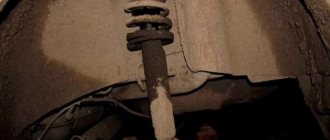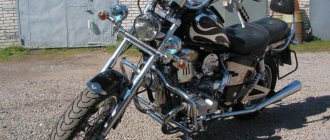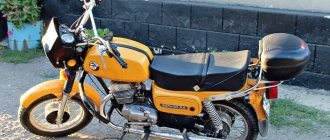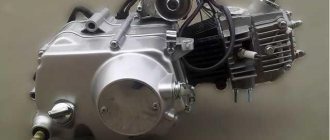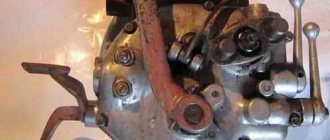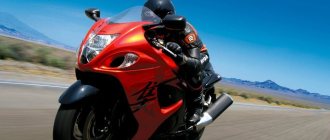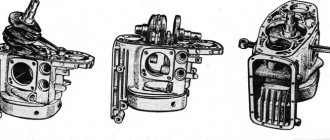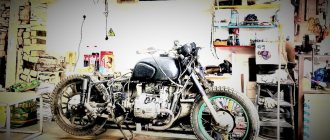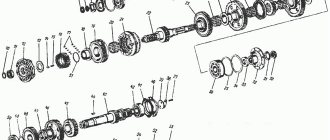MY MOTORCYCLE
The Dnepr motorcycle is one of the most popular “soviet” motorcycles in Ukraine. It is exploited everywhere and everywhere. The engine itself, of course, is as wear-resistant as in the Ural (well, to be honest, our “Kulibins” were a little unfinished), but the gearbox performed quite well. But whatever one may say, when a motorcycle is used for a long time, more or less complex malfunctions arise in the gearbox that must be repaired!
In order for repairs, usually associated with replacing worn parts, to be successful, you need to know, firstly, what caused the malfunction, and secondly, how to properly eliminate it. Otherwise, instead of one problem, you can get another. To begin with, we will characterize the main malfunctions that may occur in the box, their causes and methods of elimination, and then we will deal with the procedure for disassembling and assembling it.
Fig.1. Driven (secondary) and drive (primary) shafts, engine starting mechanism: 1, 20 - ball bearings 304; 2 — washer; 3, 7, 9, 12, 16 — driven shaft gears; 4 - bushing; 5, 10 — gear clutches; 6, 11 — driven shaft couplings; 8 — bushings; 13 — bushing; 14 - driven shaft; 15 — keys; 17 — reverse idler gear; 18 — washer; 19 — gasket; 21 — bolt of the speedometer drive bushing; 22 — thrust bushing for speedometer drive; 23 — driven gear of the speedometer shaft; 24 — speedometer drive gear; 25 — disk of the elastic coupling of the cardan; 26 — washer; 27 — nut;; 28 — cotter pin; 29 — washer; 30 - coupling; 31 - gasket; 32 — ball bearing 205; 33 — gear wheel of the fourth gear of the drive shaft; 34 — gear of the third gear of the drive shaft; 35 - drive shaft; 36 - key; 37 — washers; 38, 39 — intermediate shaft gears; 40 - spring; 41 — bushing mounting screws; 42 — front bushing of the trigger shaft; 43 — rubber sealing ring; 44 - special washer for securing the end of the spring; 45 — gear sector return spring; 46 — gear sector; 47 — trigger shaft; 48 — wedge bolt nut; 49 — washer; 50 - wedge bolt; 51 — rear bushing of the trigger shaft; 52 — lever assembly.
The start pedal goes all the way down, but the crankshaft does not turn. To determine the cause, engage the gear and press the start pedal. If the motorcycle remains motionless, it means that the teeth of gears 38 and 39 (Fig. 1 - see below) of the ratchet mechanism or the starting gear sector 46 are broken and these parts need to be replaced. If the motorcycle moves slightly, the clutch is slipping and its drive needs to be adjusted.
- The start pedal does not return to the up position. If it can be easily lifted by hand, the spring 45 of the trigger mechanism or the special washer 44, the protrusion of which the end of the spring is attached to, is broken. The spring usually breaks off the protrusion that fits into the hole of the gear sector. The washer can wear out and disengage with the cams of the bushing 42. In these cases, it is enough to replace the damaged spring or engage the washer with the cams of the bushing or sector.
- The large free play of the starting shaft lever 52 is, as a rule, a consequence of the play that has appeared in its connection with the shaft 47. It is enough to drive the wedge bolt 50 that tightens these parts harder and tighten the nut 48 to reduce the lever travel.
- One of the gears does not engage. The reason is the breakdown of one of the pins in gear shift disc 11 (Fig. 2). The disk assembly is replaced with a new one.
- Gears switch out spontaneously when the motorcycle is moving. This may be caused by incorrect adjustment of the forced clutch release mechanism, wear of the splines of couplings 5 and 10 (see Fig. 1), including gears, or gear splines. During repairs, unusable parts are replaced.
- Noisy operation of the gearbox is caused by insufficient oil in it, wear of the gear teeth or bearings of the drive or driven shafts. Worn parts should be replaced when the opportunity arises, without waiting for them to break.
To repair, the gearbox must be removed from the motorcycle and disassembled. These works are described in the instructions supplied with the machine by the factory, and usually do not cause any difficulties. Assembly is another matter. It is important here not only to install the parts in a certain order, but the main thing is to ensure the required nature of their connection. If, say, a gear must sit motionless on a shaft in order to rotate with it, then its hole in diameter must be smaller than the shaft. Conversely, a freely rotating gear must fit onto the shaft with a certain clearance. Deviations from these requirements, caused by wear of parts, disrupt the operation of the mechanism. Therefore, after disassembling and washing the parts, it is advisable to check their main dimensions, which must correspond to the values given in the table, otherwise, soon after replacing only the damaged part, the gearbox will have to be disassembled again to install a number of new ones. We recommend assembling the box in the following order, by unit:
Press into the cover 14 (Fig. 3) the ball bearing 17 of the drive shaft until it stops, the idler gear axis 15 is flush with the outer wall of the cover (tightness of at least 0.01 mm), alignment pins 16 and 19 (tension of at least 0.03 mm), rear bushing of the starting shaft (tension less than 0.025 mm) and oil seal 3. Install bracket 25, previously assembled with lever 24 and roller 22, and secure it with nut 5 with flat washer c. Install oil seal 1 into the hole for the driven shaft. Press key 36 into the drive shaft 35 (see Fig. 1) of the gearbox and then press gear 34 of the third gear onto it until it stops. The 0.05 feeler gauge should not pass between the end of the pressed gear without distortion and the shaft shoulder. Place gear 33 of the fourth gear on the shaft and bring its cams into full engagement with the cams of gear 34 of the third gear. Press ball bearing 32 onto the shaft until it touches the end of gear 33, put on gasket 31 and press coupling 30 onto the shaft so that it fits tightly onto the gasket. Place bushing 13 on the front end of the driven shaft 14 until it stops in the splines, onto it - gear 12. Press in two opposite keys 15, put coupling 11 on the shaft, and on it - coupling 10, bushings 8 and gears 9 and 7 on them. Press in the remaining two keys 15, put coupling 6 on the shaft, and on it - engagement coupling 5. Press sleeve 4 onto the shaft until it stops in coupling 6, put gear 3, washer 2 on the sleeve and press ball bearing 1 until it stops. gear 16, washer 18 and spacer 19. The entire set of parts assembled on the driven shaft will be secured when the ball bearing 20 is pressed onto its free end. All gears of the driven shaft should rotate easily on the shaft without jamming (radial clearance 0.02-0 ,1 mm), gear clutches - move freely along the splines of the driven shaft couplings. Once you are convinced of this, you can lightly lubricate all the rubbing pairs with oil, which will be used to fill the gearbox, in order to save the parts from dry friction in the first minutes of operation of the unit on the motorcycle.
Press gearshift disc axis 25 and lever lock axis 22 into crankcase 3 (Fig. 4). Screw the stop 20 of the cam-crank return spring to the crankcase with bolt 17. Screw the rubber buffer 28 of the gear sector of the trigger mechanism with lining 27 to the crankcase with two bolts 30 with washers 29 and nuts 26. The nuts must be secured with a cotter pin. Press in bushing 31 and oil seal 33 with spring 32. Press in intermediate shaft 13 with the short end. Place washer 37 on this shaft (see Fig. 1). gear 38 with the cams outward, then put the gear 39 with the cams on gear 38, the second washer 37 and spring 40.
Press axle 18 into the crankcase (see Fig. 2) and put pawl 19 on it. Install gear shift assembly with pedals into the pressed bushing 31 (see Fig. 4) and oil seal 33. Place the return spring 6 on the inside of the crankcase and place its end behind the protruding tendril of the stop 20 (see Fig. 4). Place cam-crank 7 on the splined section of the shaft (see Fig. 2), placing the second end of the spring behind the cam pin. Place spring 8 and ring 10 onto the second crank pin. Place the end of the crank pin into the shift pawl groove. Place washer 9 on the threaded end of the shift shaft and tighten it all with nut 12, which is secured with cotter pin 13. Install lever 23 (see Fig. 4) in the crankcase for engaging reverse gear. Install shift disk 11 on the axle (see Fig. 2) after first securing the gear shift disk retainer spring 17 to it. install lever lock 16 (see Fig. 2) on axle 22 (see Fig. 4), rest one end of spring 17 against the crankcase wall, and place the other end on the lock. Place washer 15 (see Fig. 2) on axle 22 (see Fig. 4), insert cotter pin 14 into the hole of the axle and separate its ends.
Now you can move on to the general assembly of the gearbox. Press the previously assembled drive and driven shafts into the crankcase. Insert gear shift forks 1 and 2 (see Fig. 2) into the grooves of the couplings switching the driven shaft and into the groove of gear 16 (see Fig. 1) reverse gear fork 3 (see Fig. 2). Insert roller 4 into the holes of the shift forks and install it in the corresponding hole in the crankcase. Insert the pins of gearshift forks 1 and 2 into the grooves of the shift disk, and insert the pin of the reverse gear lever into the groove of the fork 3. Screw the stop 14 (see Fig. 4) of the idler gear to the crankcase with screw 15. Screw in the sensor contact with plug 5. Install the assembled gearbox cover onto the shafts, having previously coated their planes and the gasket with some sealing compound. With light blows of a hammer (not steel), seat the cover until the planes touch and tighten the nine coupling bolts 7 crosswise (see Fig. 3) with washers 8 on them. In the assembled box, the shafts and gears should rotate easily by hand without jamming. Press drive gear 24 (see Fig. 1) of the speedometer drive onto the shank of disk 25 of the elastic coupling. Using light blows of a hammer, press the elastic coupling disk assembly onto the driven shaft so that the hole for the cotter pin is between the fingers of the disk. Place washer 26, tighten nut 27 as far as possible and secure it. Insert the driven gear 23 of the speedometer shaft into the hole in the crankcase, having previously lubricated its lower end with grease, insert the bushing 22 N through the recess on it and screw in bolt 21. To wind the return spring of the starting shaft sector, it is necessary to turn the front bushing 42 180° counterclockwise and secure it two screws. Install lever 52 on the protruding end of the trigger shaft and secure it with wedge bolt 50. Install the clutch release mechanism and screw in drain plug 9 (see Fig. 3) with washer 10 and breather 13 assembled with dipstick 12.
After installing the gearbox on your motorcycle, do not forget to fill it with oil.
That's the whole robot. If you understand it well, it’s not difficult at all - the main thing is to be careful!
Engine and power system on motorcycles
Without any alteration, the following can be considered interchangeable: carburetors, piston rings, connecting rod upper end bushings, piston pin and its retaining rings, valve springs and their retainers, as well as all clutch parts except the flywheel. Conventionally, the pistons can also be considered interchangeable, but in the case of installing KMZ pistons on a Ural motorcycle, you will have to cut the skirt (for example, along the lower oil scraper ring). Complete engines are also interchangeable, but together with the “original” exhaust pipes.
Transmission.
Final drive (“axle”) on motorcycles
Despite the different external shapes and slight differences in the drive of the brake pads, the axles are interchangeable. Problems with the number and diameter of studs securing the main gear to the pendulum can be solved quite simply with the help of a drill and taps. All parts hidden inside the “bridge” are also interchangeable, although they may have slight differences depending on the age of the unit. In the case of installing a “Dnepr” “bridge” on a “Ural” motorcycle, a rear wheel from a “Dnepr” may also be required, since the “Ural” wheel is multi-spoke and can rub the brake drum against the fist.
Chassis.
The front telescopic forks and spring-hydraulic suspension elements of the rear wheel and sidecar wheels are absolutely identical on motorcycles. These units are interchangeable both as a whole and in small details. But you need to avoid the combination of a “Ural” wheel with a stamped brake drum and “Dnieper” brake shields; the reverse combination is absolutely workable. If we consider the wheel as a set of parts, then the rim and all the insides of the hub can be considered the same: bearings, spacers and nuts with oil seals.
Electrical components on motorcycles can be considered absolutely identical: a generator, a relay regulator, a breaker with an automatic advancer, an ignition coil, as well as all lighting equipment and switches on the handlebars.
They are different in shape, but have the same seats: a gas tank, a front fender, a double saddle (you will need to rotate the saddle lock on the frame 180°), a steering wheel with fasteners and a stroller awning.
Checkpoint Ural or Dnepr?
Please tell me. I want to install a new gearbox. Experienced men in the market said that 1) the Ural gearbox with reverse gear is “raw” and basically unfinished by the manufacturer. 2) The Dnepr gearbox is originally with reverse gear and is made better and more reliable. It is also faster. Who thinks which is better, the Ural or the Dnieper? Is the checkpoint from the Dnieper installed in the Urals one to one in a regular place? Thanks in advance
Nenad has nothing to file, the box stands up normally, you can only try to file the cardan, or, as was said above, install the Dnieper box together with the cardan. IMHO the Dnieper box is still better!
about working with a file: it’s probably different on different models and years :) it’s still decided according to the location.
The gear ratios are the same in the Urals and the Dnieper. The Dnieper box mega-rules nevertheless.
The dneprocorb definitely works better!
Ural Korobas has not changed since BMW times, only in appearance
A drip box is definitely needed. And the crankcase will have to be slightly modified on one eye of attachment to the frame. The cardan is shorter and the original clutch cable is needed ideally.
Right now I’m bothering with installing a drip box on 8.103.10. So, although everyone says it’s easy, the bottom box fits into my frame, but there’s no room left for the coupling(((You don’t have to file the eyelet. Anyway, to install the box I had to unscrew the top engine mount and pull out the front pin engine mounts. Now I machined the Dneprocardan rear fork on a machine and ground off the coupling rubber 3 mm on each side. I gained about 1 cm. I'll go experiment. The bike was produced in 1994, and along the way, the frame sizes are still different for everyone. The costs of the domestic motorcycle industry are so say. And you yourself know the quality of the parts. One shoulder of the rear fork is machined 4 mm less than the other.
In short, it's a kick-ass. Nothing succeeded. Since there is no desire to digest the engine mount, I will install a Ural gearbox (((
Who needs a drip box? (((
I like the Ural Box. everyone is satisfied. Over the years there has been virtually no wear and tear (1984), but I plan to install a Dneprokorobka. because It is possible to put 5th gear. )))
I tore the second gear gear on my Ural gearbox 3 (THREE) times. And on the asphalt. Either the quality of the gears was bad or who knows.
Is your gearbox completely attached to the engine? Often, without sharpening the left rear ear of the Ural engine, the MT gearbox is not completely docked to the engine. In one book, when installing the MT-804 gearbox on early model motorcycles, if the fork gets caught on the frame, it is recommended to slightly sharpen the pendulum mounting unit at the point of engagement. Book "Motorcycles Ural, Dnepr".
The link to download this book is in the topic “Instructions for the Dnepr checkpoint” page 97. Fig. 4.13
Is your gearbox completely attached to the engine? Often, without sharpening the left rear ear of the Ural engine, the MT gearbox is not completely docked to the engine.
Fully. I had to sharpen it when I installed it without moving the engine forward.
Then the sander is in your hands and just like in the book.
In other respects, Dnieper is better.
On the Dnieper, between the 1st and 2nd and between the 3rd and 4th, the fishing is much clearer than on the Ural.
I also had it on M67. Now I have 8.103
the difference between the Dnipro box and the Uralyacha...
Peoples, that’s the subject. I've heard a lot that the Dnieper river will be better. But what? And what is this mysterious (for me) semi-automatic on the Dnieper?
Semi-automatic like in Java or Yupaca.
They say that neutral is better caught. This is true?
This is probably what you meant by the shift disk. Otherwise a person will look for a round dog with guides there
How about putting a starter in the Dnieper? Whether it is installed or not.
for Kangaroo
: So you put it on the Ural, and not just on the Dnieper (the gearbox doesn’t matter here), you pull out the starter, which rotates counterclockwise, cut the teeth on the flywheel (or take the Voyazhev flywheel, it already has teeth), make a hole in the crankcase (under the flywheel engagement by the starter) you weld the fasteners of this starter with argon, muddy up the wiring, put on the
RED BUTTON
(preferably taken from
the nuclear suitcase
), take the battery for help, and adjust everything. yeah, sorry about that.
[Edited 9/23/2003 Kmfbs]
:))))))))))))) and the missiles are probably aimed at the Yamahamoto, Suzukimoto, Hondamoto and HD factories. :)))))))))))
Kmfbs:—-na vse krome HD, milosti prosem :-))
for kpect
: We talk about his family and cormorants.
a bolshe drygoy xoroshey texniki nety krome Harley Davison
for yura_Y2K
: Factory Harley is a decent piece of crap (it’s not clear why you should pay that kind of money.)
for Kmfbs
: situYovina:
my brother installed the Dnipryachya checkpoint in the Urals. As a result, for the second time, the spline on the clutch disc is worn out ONLY ON THE ONE WHICH IS CLOSER TO THE TRANSMISSION. The clutch is assembled correctly.
what's wrong? It feels like the (primary) shaft only clings to one disc. Could this be possible?
Normally, the Ural box 8.103 is disassembled and assembled. The main thing is that during disassembly the shafts do not fall out and the adjusting washers do not fly off, otherwise it would be a hassle to find them around the garage and determine where they were. And when assembling, you just need to act carefully and make sure that the edges of the seals do not curl up. Well, you also need to cock the kick spring, but with two people there’s no question at all, and even one can get the hang of it.
There are real problems with neutral in the Urals. With the engine running, it is almost impossible to find neutral. When I opened the box, I realized that the problem was the unfortunate trajectory of the shift forks. There are two shift forks, first-second and third-fourth. The forks have two end points of travel: first gear and second, and third and fourth. The shift foot stop is adjusted so that the stroke of the shift shaft is such that the forks are thrown from one point to another and the fixation ball falls into the hole. And the neutral is made in the middle of the stroke of the 1-2 gear shift fork, and when you press a little harder on the shift foot, the fork simply flies past the neutral from one end point to another because the ball does not stay in the hole even with high applied force.
I suspect that this was done to make it easier to switch from first to second immediately, rather than through neutral. Like you push the lever all the way and you go straight from first to second, and you push slightly so that the ball hits the hole and locks neutral, but doesn’t go any further and you’ll be in neutral. The idea may have been good, but the execution was poor.

